Topical Analgesic Market Size
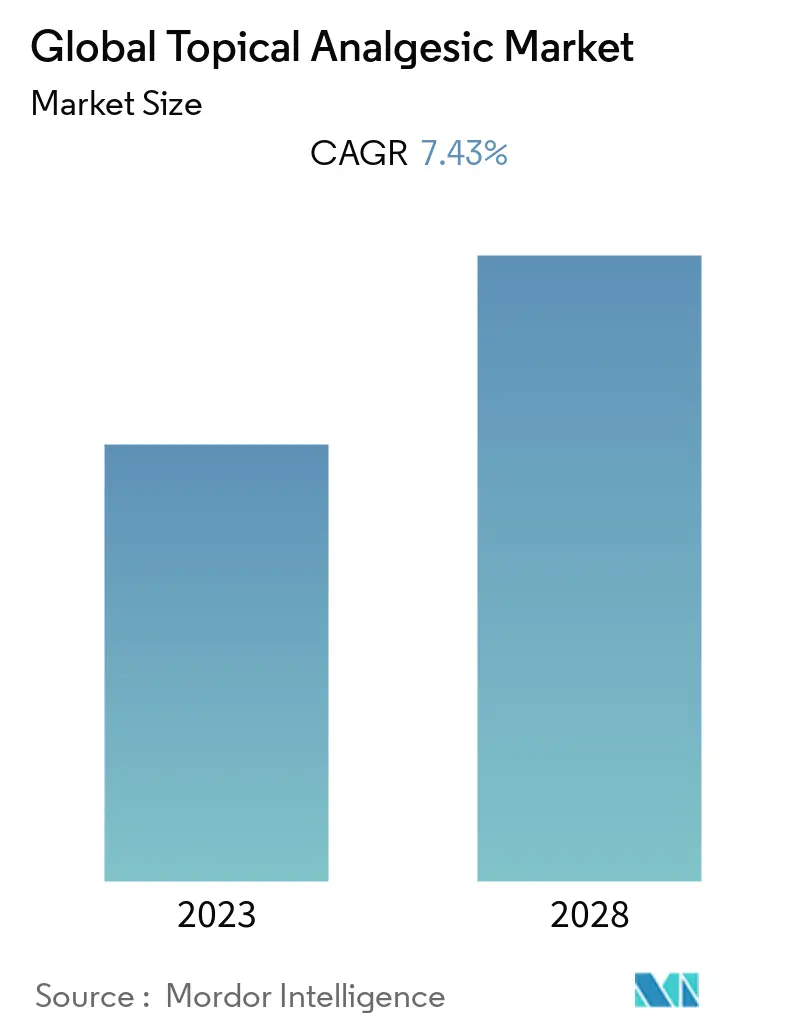
| Study Period | 2018 - 2028 |
| Base Year For Estimation | 2021 |
| CAGR | 7.43 % |
| Fastest Growing Market | Asia Pacific |
| Largest Market | North America |
| Market Concentration | Medium |
Major Players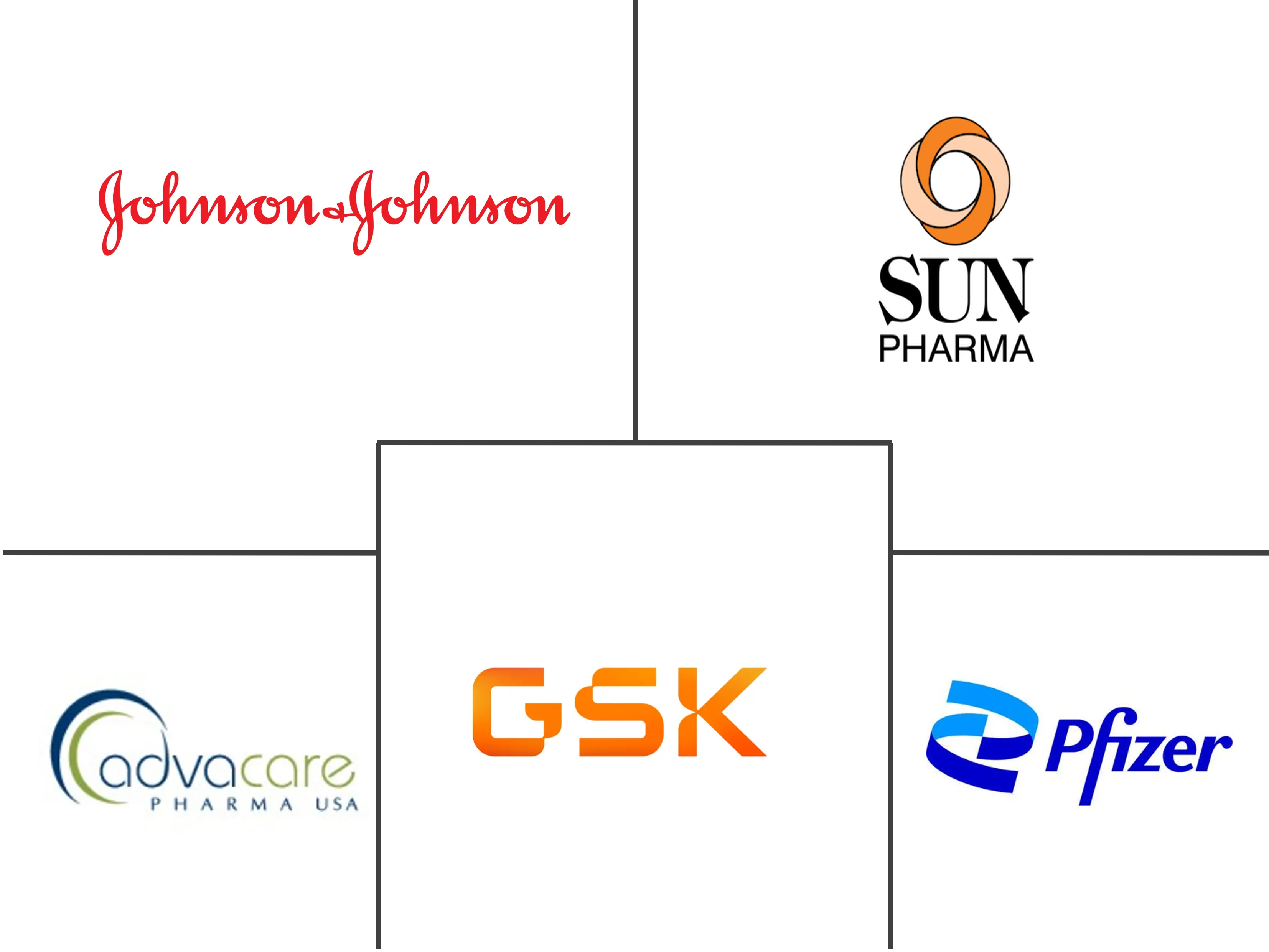
*Disclaimer: Major Players sorted in no particular order |
Need a report that reflects how COVID-19 has impacted this market and its growth?
Topical Analgesic Market Analysis
The topical analgesic market is poised to grow at a CAGR of 7.43% during the forecast period (2022-2027).
The COVID-19 pandemic is expected to have a significant effect on the market. In recent times, countries have faced a huge threat of COVID-19. As per the World Health Organization (WHO), COVID-19 is an infectious disease, and most people infected with the SARS-CoV-2 virus may experience mild to moderate respiratory illnesses. Owing to the situation, most pharmaceutical and biotechnological companies are focusing their R&D departments on identifying new molecules or leads for the treatment of this disease. In order to keep hospitals operating at capacity and stop the virus from spreading, the COVID-19 pandemic has also led to a period of isolation. Additionally, one of the areas most severely impacted by the COVID-19 pandemic was chronic pain, which resulted in many patients having too much discomfort and experiencing delays in their continued therapies. For instance, according to a research article by Rajendra K Sahoo et al., published in the Indian Journal of Anesthesia 2020, it was found that 63.16% of pain doctors were concerned about infecting or spreading the illness to the patient's family, 26.79% had trouble sleeping, 1.43% felt depressed, and 8.14% were anxious.
However, the demand for pain medications, such as topical analgesics, greatly increased over the pandemic. According to a study titled, ‘The effect of SARS-CoV-2 on the prescribing of antimicrobials and analgesics by NHS general dental practitioners in England’, published in January 2021, opioids drugs demand during April 2020 was about 28,563, while in April 2019, it was 15,507, increase by approximately 84%. This indicates that the rising demand for pain medications is further expected to strain the supply scale, leading to shortages of these medications.
Certain factors that are driving the market growth include the increasing prevalence of arthritis, rising cases of sports-related injuries, and the growing geriatric population. Osteoarthritis (OA) is not only the most common joint disease but also one of the major causes of disability in people aged 65 years and above. The disease is accompanied by comorbid conditions, increased mortality, and decreased quality of life. The increasing geriatric population is one of the important drivers propelling the growth of the topical analgesic market. Age is associated with a progressive decline of the functional reserve of multiple organ systems. Elderly patients are likely to utilize a disproportionate share of healthcare resources, as about 92% of older adults have at least one chronic disease, and 77% have at least two. For instance, according to data from World Population Prospects 2022, in 2022, there were 771 million people aged 65 years or over globally, 3 times more than the size in 1980 (258 million). The older population is projected to reach 994 million by 2030 and 1.6 billion by 2050. The share of the global population aged 65 years or above is projected to rise from 10% in 2022 to 16% in 2050. Moreover, according to the Centers for Disease Control and Prevention (CDC) statistics updated in 2021, an estimated 63 million Americans have been diagnosed with arthritis in 2020, and this number is estimated to reach 78 million by 2040. These factors are expected to drive the growth of the market.
The global increase in the number of geriatrics is expected to lead to consequences, such as greater incidences of chronic and life-threatening diseases. Consequently, the geriatric population is at a higher risk of musculoskeletal disorders. Thus, the rise in the geriatric population is acting as a major driver for the growth of the topical analgesic market.
However, side effects related to topical analgesics are expected to hinder the growth of the market over the forecast period.
Topical Analgesic Market Trends
This section covers the major market trends shaping the Topical Analgesic Market according to our research experts:
Non-opioids are Expected to Hold Significant Market Share in the Drug Type
Topical non-opioids are found to be more effective in treating acute pain from strains, sprains, contusions, or overuse injuries in superficial locations.
As per, the Center for Diseases Control and Prevention in May 2020, around 43% of the population suffers from pain on some days and around 20% of the population suffers from pain every day or on most days. There are numerous risk factors for chronic pain. Non-opioid analgesics are preferable because it does not involve the risk of addiction as with an opioid drug, therefore, helping in managing the pain for a longer duration and are considered a valuable driver for the Non-opioid market.
Moreover, according to the article titled "Epidemiology and classification of diabetic neuropathy" updated in January 2021, diabetic polyneuropathy is the most common neuropathy in developed countries. It also reported that approximately 50% of patients with diabetes will eventually develop neuropathy. Thus, rising neuropathic pain cases and the widespread availability of non-opioid pain topical analgesics are expected to drive the segment growth.
In February 2022, NEXGEL, Inc. a provider of ultra-gentle, high-water-content hydrogel products for healthcare and consumer applications, reported the launch of its MEDAGEL Bug Bite Relief Patch. These cooling patches, made in the United States using NEXGEL's soothing hydrogel technology, provide instant relief to irritated skin caused by insect bites.
Furthermore, the increasing burden of diseases, along with the safety profile and efficacy associated with non-opioid topical analgesics are expected to drive the growth of the Non-opioids market segment during the forecast period.
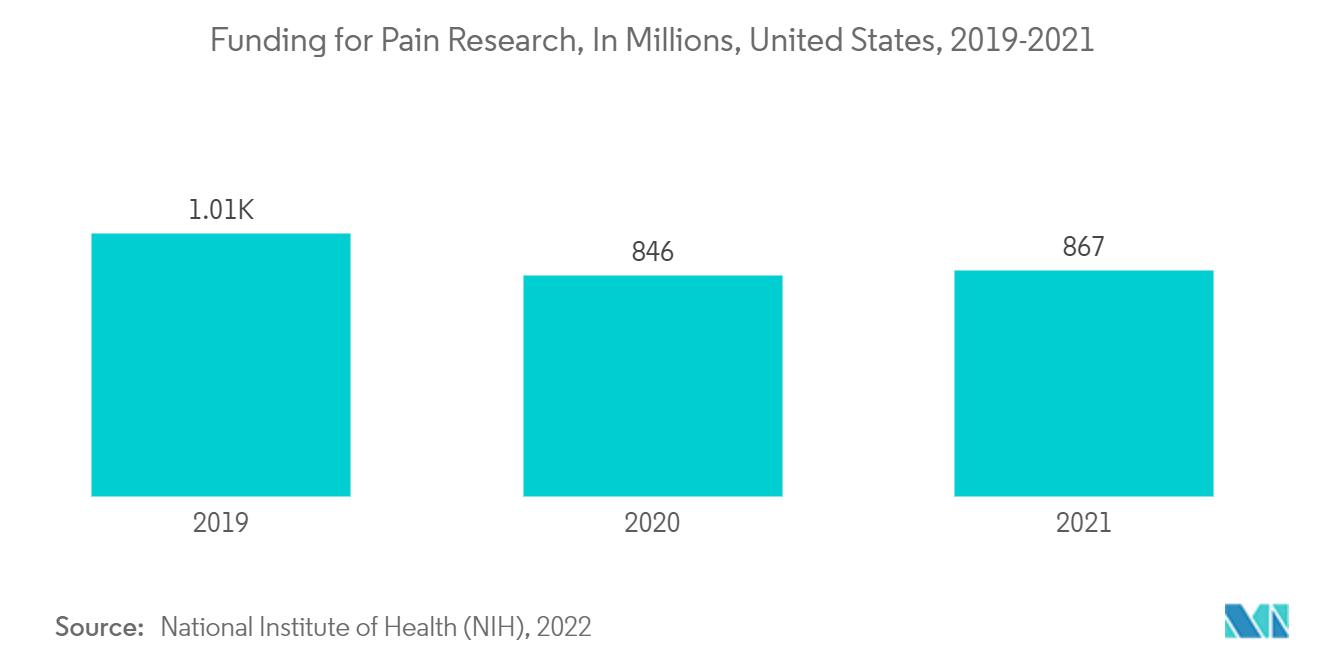
The Market is Dominated by North America and is Expected to do Same in the Forecasted Period
North American topical analgesics are estimated to dominate the industry, owing to well-established healthcare facilities, the rising geriatric population, and the growing prevalence of chronic pain.
As per the Centers for Disease Control and Prevention (CDC) statistics update of 2020, while there are estimated to be more than 100 types of arthritis, osteoarthritis (OA) is the most common form of arthritis, affecting 32.5 million United States adults. Also, women are more likely to develop OA than men, especially after age 50. Thus, an increase in the number of osteoarthritis among women in the country will also increase the demand for topical analgesics, therefore driving the growth of the market.
Moreover, sports like basketball and football were the major injury-causing factors in the United States. As per the National Safety Council’s data updated in 2020, due to basketball and football, there were 214,847 and 122,181 injuries were reported in the United States. Thus, high sports-related injuries are expected to drive the demand for topical analgesics.
Associations such as the Arthritis Foundation and Osteoarthritis Centers of America are continuously making efforts to eliminate the causes of OA in the population by increasing awareness. Moreover, easy access to quality healthcare and favorable reimbursement policies are projected to promote the growth of the market in the region. For instance, knee replacement surgery is covered under Medicare Part A or B depending on the service and the attending specialist. This factor is likely to boost the rate of treatment among Americans.
Additionally, in February 2020, GlaxoSmithKline announced that the United States Food and Drug Administration (FDA) had approved Voltaren Arthritis Pain Gel as an over-the-counter (OTC) topical analgesic for the temporary relief of arthritis pain in the hand, wrist, elbow, foot, ankle, or knee in adults (18 years and older).
Therefore, owing to the above-mentioned factors, the growth of the topical analgesics market in North America is expected to drive over the forecast period.
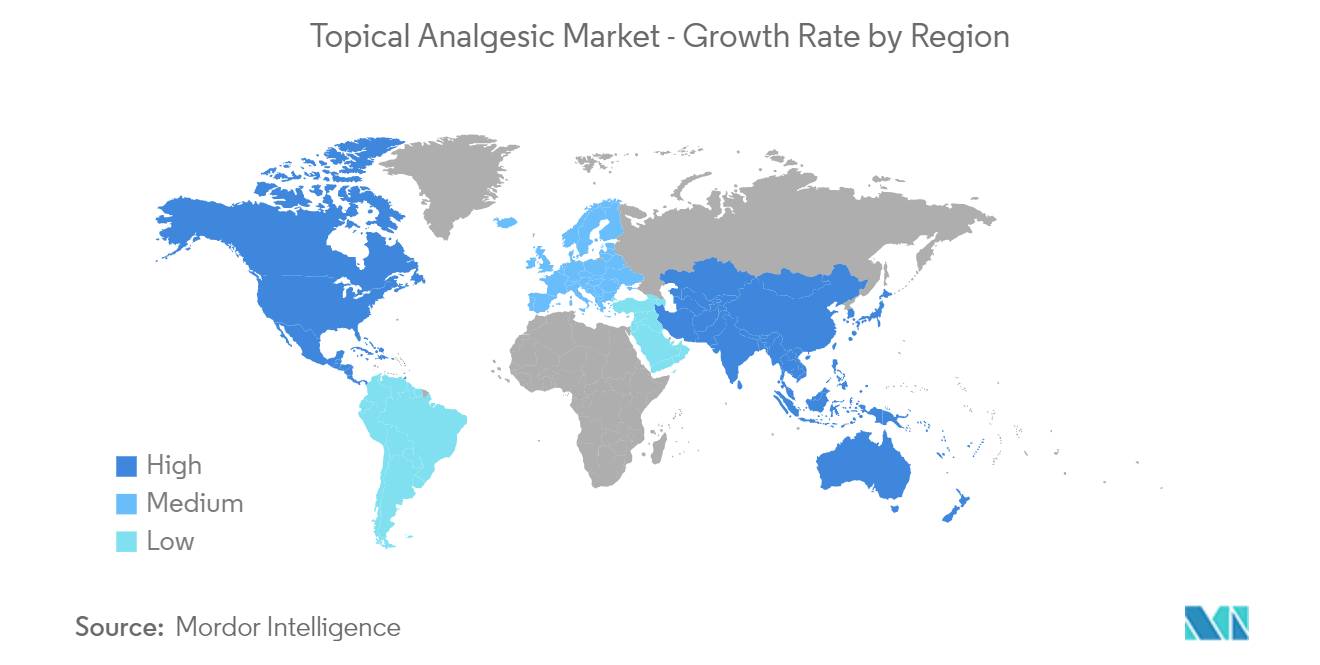
Topical Analgesic Industry Overview
The market for the topical analgesic market is highly fragmented and a majority of topical analgesic products are being manufactured by key players. The market leaders in this industry have established their position in the market, and these manufacturers have a wide product range to offer and an extensive distribution system across the world. Additionally, the topical analgesic market is highly competitive and consists of several major players. Companies like GlaxoSmithKline plc., Johnson & Johnson, Pfizer Inc., Sun Pharmaceutical Industries Ltd, and AdvaCare Pharma among others, hold a substantial market share in the topical analgesic market.
Topical Analgesic Market Leaders
GlaxoSmithKline plc.
Johnson & Johnson
AdvaCare Pharma
Pfizer Inc.
Sun Pharmaceutical Industries Ltd
*Disclaimer: Major Players sorted in no particular order
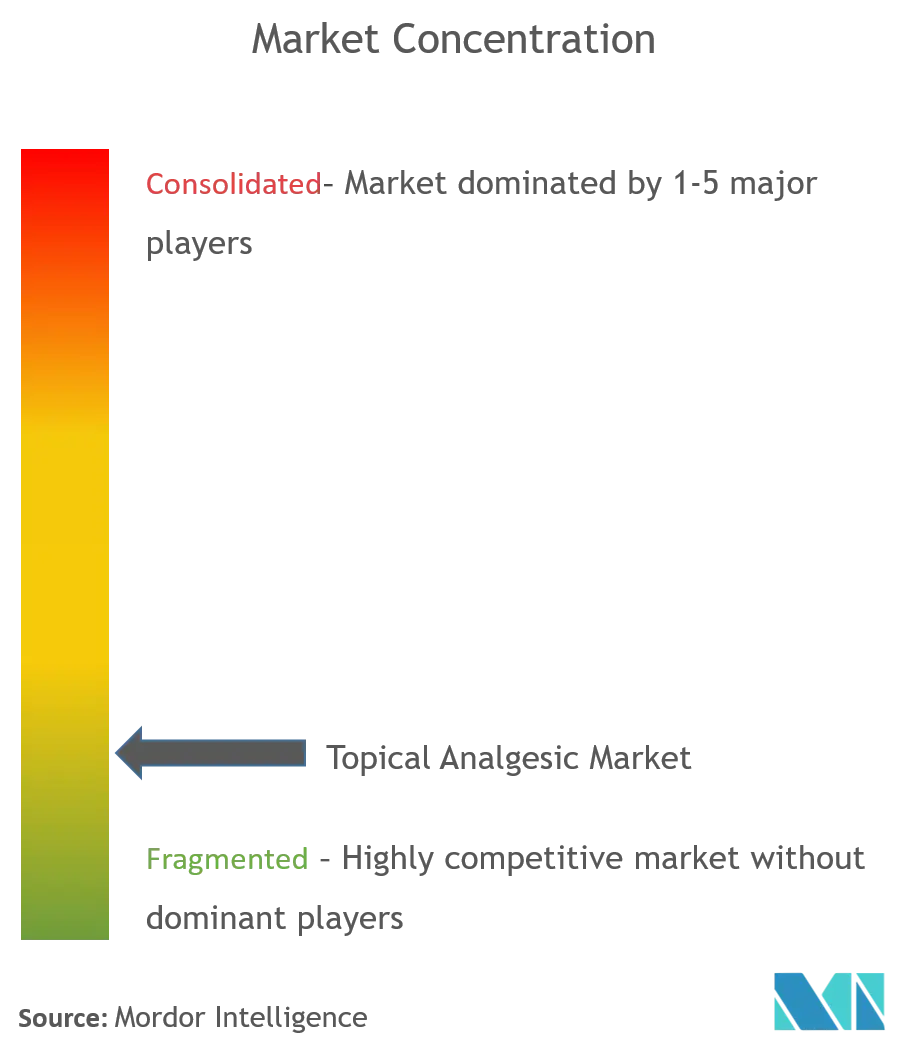
Topical Analgesic Market News
- In August 2022, Blue Echo Care won the Drug Store News Buyers’ Choice Award.
- In March 2021, Hisamitsu America, a division of Hisamitsu Pharmaceutical Co., Inc., launched the Salonpas Arthritis Pain Relief Gel, which features the most prescribed topical pain medicine clinically proven to relieve arthritis pain in major joints.
Topical Analgesic Market Report - Table of Contents
1. INTRODUCTION
1.1 Study Assumptions and Market Definition
1.2 Scope of the Study
2. RESEARCH METHODOLOGY
3. EXECUTIVE SUMMARY
4. MARKET DYNAMICS
4.1 Market Overview
4.2 Market Drivers
4.2.1 Increasing Prevalence of Arthritis
4.2.2 Rising Cases of Sports related Injuries
4.2.3 Growing Geriatric Population
4.3 Market Restraints
4.3.1 Side Effects Related to Topical Analgesics
4.4 Porter's Five Force Analysis
4.4.1 Threat of New Entrants
4.4.2 Bargaining Power of Buyers/Consumers
4.4.3 Bargaining Power of Suppliers
4.4.4 Threat of Substitute Products
4.4.5 Intensity of Competitive Rivalry
5. MARKET SEGMENTATION
5.1 Drug Type
5.1.1 Non Opioids
5.1.1.1 Nonsteroidal anti-inflammatory drugs (NSAIDS)
5.1.1.2 Capsaicin
5.1.1.3 Lidocaine
5.1.1.4 Methyl salicylates
5.1.1.5 Other Drug Types
5.1.2 Opioids
5.2 Formulation
5.2.1 Cream
5.2.2 Patch
5.2.3 Spray
5.2.4 Gel
5.2.5 Other Formulations
5.3 Type
5.3.1 Over the Counter (OTC) Analgesic
5.3.2 Prescription Analgesic
5.4 Geography
5.4.1 North America
5.4.1.1 United States
5.4.1.2 Canada
5.4.1.3 Mexico
5.4.2 Europe
5.4.2.1 United Kingdom
5.4.2.2 Germany
5.4.2.3 France
5.4.2.4 Italy
5.4.2.5 Spain
5.4.2.6 Rest of Europe
5.4.3 Asia-Pacific
5.4.3.1 China
5.4.3.2 Japan
5.4.3.3 India
5.4.3.4 Australia
5.4.3.5 South Korea
5.4.3.6 Rest of Asia-Pacific
5.4.4 Middle East and Africa
5.4.4.1 GCC
5.4.4.2 South Africa
5.4.4.3 Rest of Middle East and Africa
5.4.5 South America
5.4.5.1 Brazil
5.4.5.2 Argentina
5.4.5.3 Rest of South America
6. COMPETITIVE LANDSCAPE
6.1 Company Profiles
6.1.1 AdvaCare Pharma
6.1.2 GlaxoSmithKline plc.
6.1.3 Johnson & Johnson
6.1.4 Pfizer Inc.
6.1.5 Hisamitsu Pharmaceutical co.,inc.
6.1.6 Sanofi
6.1.7 Sun Pharmaceutical Industries Ltd
6.1.8 Topical BioMedics, Inc.
6.1.9 Teva Pharmaceutical Industries Ltd
6.1.10 Bayer AG
6.1.11 Reckitt Benckiser Group PLC
6.1.12 Takeda Pharmaceutical Company Limited
- *List Not Exhaustive
7. MARKET OPPORTUNITIES AND FUTURE TRENDS
Topical Analgesic Industry Segmentation
Topical analgesics are recommended to use when patients experience acute and chronic muscle and joint pain, to get relief from their symptoms. The products are applied directly to the skin, instead of being injected or swallowed. The topical analgesics are available in the form of creams, lotions, sprays, gel, or patches. The topical analgesics are obtained as prescription analgesics and OTC analgesics as well. However, several factors must be considered when selecting an OTC topical analgesic, which include dosage form, cost, ease of use, odor, and the patient’s medical history, including possible allergies.
The Topical Analgesic Market is segmented by Drug Type (Non-Opioids, Opioids), Formulation (Cream, Patch, Spray, Gel, Other Formulations), Type (Over Counter (OTC) Analgesic and Prescription Analgesic), and Geography (North America, Europe, Asia-Pacific, Middle East, and Africa, and South America). The market report also covers the estimated market sizes and trends for 17 different countries across major regions, globally. The report offers the value (in USD million) for the above segments.
| Drug Type | |||||||
| |||||||
| Opioids |
| Formulation | |
| Cream | |
| Patch | |
| Spray | |
| Gel | |
| Other Formulations |
| Type | |
| Over the Counter (OTC) Analgesic | |
| Prescription Analgesic |
| Geography | ||||||||
| ||||||||
| ||||||||
| ||||||||
| ||||||||
|
Topical Analgesic Market Research FAQs
What is the current Global Topical Analgesic Market size?
The Global Topical Analgesic Market is projected to register a CAGR of 7.43% during the forecast period (2023-2028).
Who are the key players in Global Topical Analgesic Market?
GlaxoSmithKline plc., Johnson & Johnson, AdvaCare Pharma, Pfizer Inc. and Sun Pharmaceutical Industries Ltd are the major companies operating in the Global Topical Analgesic Market.
Which is the fastest growing region in Global Topical Analgesic Market?
Asia Pacific is estimated to grow at the highest CAGR over the forecast period (2023-2028).
Which region has the biggest share in Global Topical Analgesic Market?
In 2023, the North America accounts for the largest market share in the Global Topical Analgesic Market.
Topical Painkiller Industry Report
Statistics for the 2023 Topical Painkiller market share, size and revenue growth rate, created by Mordor Intelligence™ Industry Reports. Topical Painkiller analysis includes a market forecast outlook to 2028 and historical overview. Get a sample of this industry analysis as a free report PDF download.
